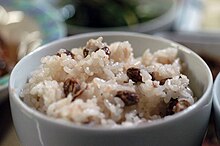
Korean cuisine has evolved through centuries of social and political change. Originating from ancient agricultural and nomadic traditions in Korea and southern Manchuria, Korean cuisine reflects a complex interaction of the natural environment and different cultural trends.

Miso is a traditional Japanese seasoning. It is a thick paste produced by fermenting soybeans with salt and kōji and sometimes rice, barley, seaweed, or other ingredients. It is used for sauces and spreads, pickling vegetables, fish, or meats, and mixing with dashi soup stock to serve as miso soup, a Japanese culinary staple. Miso is high in protein and rich in vitamins and minerals, and it played an important nutritional role in feudal Japan. Miso is still widely used in both traditional and modern cooking in Japan and has been gaining worldwide interest.

Porridge is a food made by heating or boiling ground, crushed or chopped starchy plants, typically grain, in milk or water. It is often cooked or served with added flavourings such as sugar, honey, (dried) fruit or syrup to make a sweet cereal, or it can be mixed with spices, meat or vegetables to make a savoury dish. It is usually served hot in a bowl, depending on its consistency. Oat porridge, or oatmeal, is one of the most common types of porridge. Gruel is a thinner version of porridge and congee is a savoury variation of porridge of Asian origin.

Fried rice is a dish of cooked rice that has been stir-fried in a wok or a frying pan and is usually mixed with other ingredients such as eggs, vegetables, seafood, or meat. It is often eaten by itself or as an accompaniment to another dish. Fried rice is a popular component of East Asian, Southeast Asian and certain South Asian cuisines, as well as a staple national dish of Indonesia. As a homemade dish, fried rice is typically made with ingredients left over from other dishes, leading to countless variations. Fried rice first developed during the Sui Dynasty in China and as such all fried rice dishes can trace their origins to Chinese fried rice.

Bibimbap, sometimes romanized as bi bim bap or bi bim bop, is a Korean rice dish.

Korean royal court cuisine was the style of cookery within Korean cuisine traditionally consumed at the court of the Joseon Dynasty, which ruled Korea from 1392 to 1910. There has been a revival of this cookery style in the 21st century. It is said that twelve dishes should be served along with rice and soup, with most dishes served in bangjja (bronzeware).

Rice and beans, or beans and rice, is a category of dishes from many cultures around the world, whereby the staple foods of rice and beans are combined in some manner. The grain and legume combination provides several important nutrients and many calories, and both foods are widely available. The beans are usually seasoned, while the rice may be plain or seasoned. The two components may be mixed together, separated on the plate, or served separately.
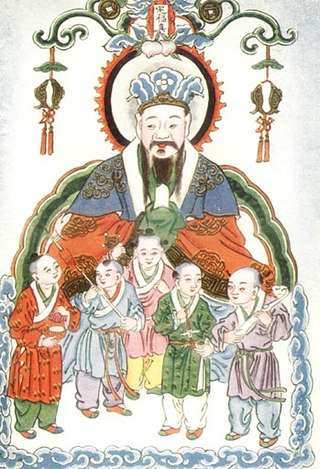
The Five Grains or Cereals are a grouping of five farmed crops that were all important in ancient China. Sometimes the crops themselves were regarded as sacred; other times, their cultivation was regarded as a sacred boon from a mythological or supernatural source. More generally, wǔgǔ can be employed in Chinese as a synecdoche referring to all grains or staple crops of which the end produce is of a granular nature. The identity of the five grains has varied over time, with different authors identifying different grains or even categories of grains.

Cooked rice refers to rice that has been cooked either by steaming or boiling. The terms steamed rice or boiled rice are also commonly used. Any variant of Asian rice, African rice or wild rice, glutinous or non-glutinous, long-, medium-, or short-grain, of any colour, can be used. Rice for cooking can be whole grain or milled.
Korean regional cuisines are characterized by local specialties and distinctive styles within Korean cuisine. The divisions reflected historical boundaries of the provinces where these food and culinary traditions were preserved until modern times.

Ogok-bap (오곡밥) or five-grain rice is a bap made of glutinous rice mixed with proso millet, sorghum, black beans, and red beans. It is one of the most representative dishes of Daeboreum, the first full moon of the year in the Korean lunar calendar. In the past, the custom of eating ogokbap with boreum-namul (vegetables) and bureom (nuts) on this day helped people replenish nutrients that have been lost during the winter months, when food was scarce. Today, ogokbap is still enjoyed by Koreans for its nutritional and health benefits. It is a common diet food, and an increasing number of people replace their daily white rice with ogokbap, due to a rise in lifestyle diseases like high blood pressure, diabetes, and angina.

Bap is a Korean name for cooked rice prepared by boiling rice or other grains, such as black rice, barley, sorghum, various millets, and beans, until the water has cooked away. Special ingredients such as vegetables, seafood, and meat can also be added to create different kinds of bap. In the past, except for the socially wealthy class, people used to eat mixed grain rice together with beans and barley rather than only rice.
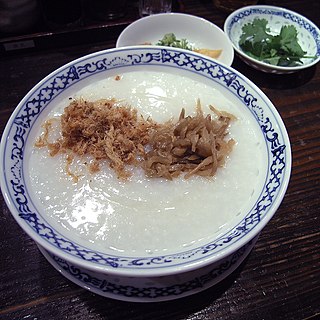
Congee or conjee is a type of mostly savoury rice porridge or gruel of Asian origin. It can be eaten plain, where it is typically served with side dishes, or it can be served with ingredients such as meat, fish, seasonings and flavourings, most often savory, but sometimes sweet. It is typically served as a meal on its own, especially for breakfast or people who are ill. Names for congee are as varied as the style of its preparation, but all are made with rice cooked as a softened porridge with a larger quantity of water than other types of cooked rice like pilaf or claypot rice.
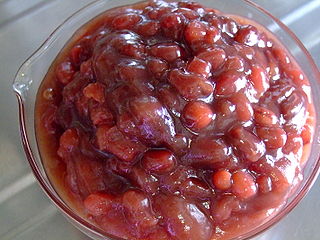
Red bean paste or red bean jam, also called adzuki bean paste or anko, is a paste made of red beans, used in East Asian cuisine. The paste is prepared by boiling the beans, then mashing or grinding them. At this stage, the paste can be sweetened or left as it is. The color of the paste is usually dark red, which comes from the husk of the beans. In Korean cuisine, the adzuki beans can also be husked prior to cooking, resulting in a white paste. It is also possible to remove the husk by sieving after cooking, but before sweetening, resulting in a red paste that is smoother and more homogeneous.
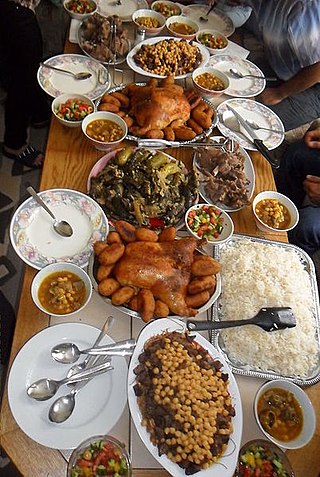
Middle Eastern cuisine or West Asian cuisine includes Arab, Armenian, Assyrian, Azerbaijani, Cypriot, Egyptian, Georgian, Iranian, Iraqi, Israeli/Jewish, Kurdish, Lebanese, Palestinian and Turkish cuisines. Common ingredients include olives and olive oil, pitas, honey, sesame seeds, dates, sumac, chickpeas, mint, rice and parsley, and popular dishes include kebabs, dolmas, falafel, baklava, yogurt, doner kebab, shawarma and mulukhiyah.
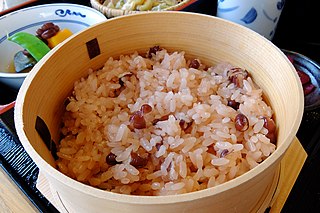
Red bean rice, called patbap (팥밥) in Korean, sekihan (赤飯) in Japanese, and hóngdòu fàn (红豆饭) in Chinese, is an East Asian rice dish consisting of rice cooked with red beans.
